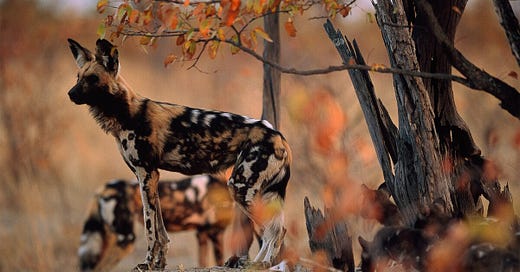by Richard Conniff
This is one of my favorite stories, and the opening chapter in my book Swimming With Piranhas at Feeding Time. It was the summer of 1997 and I was spending six weeks wandering southern Africa for two or three different wildlife stories. My itinerary took me to Maun, Botswana, where I rented a four-wheel-drive vehicle and followed directions for the biologist I was heading to see: Drive two hours north into the Okavango Delta, and turn left. I’ll post the resulting story in six parts over the next few days.
Somewhere deep in Botswana's Okavango Delta, a million miles from nowhere, a dog named Nomad leads his pack on a wild chase through the bush. The sun paints a gaudy orange stripe across the horizon. Night threatens at any moment to rush down and set the leopards afoot. Our Land Rover bucks and jumps through a dense thicket of mopane trees, and then breaks out onto a flood plain through the catpiss smell of windshield-high sage. Giraffes and tsessebe scatter ahead of us, kicking up panicky clouds of dust. Nomad is the orphan child of a male named Chance and a bitch named Fate, and maybe more sensible men would take the hint and give up, go home, get dinner.
The driver, a wildlife biologist named John "Tico" McNutt, spots a herd of impala, fast food for the wild dogs we are following. But there are no dogs in sight. He listens to his earphones for the signal from Nomad's radio collar, and then the Land Rover dives back into the forest. "Uh-oh," McNutt says, as he muscles the wheel one way and then the other through a thicket of obstacles. "Uh-oh." He circles a tree once to get his bearings, and then lurches off in the direction that makes his earphones ping strong as a heartbeat. Thorny acacia branches howl down the sides of the truck and leap in at the open windows. A rotten log explodes under our tires, showering us with debris. "Captain, we've been hit!” McNutt reports and guns the engine.
And then we see the dogs out ahead of us, long-legged and light-footed, seeming barely to skim the ground as they hunt. They stand about 2 feet tall at the shoulder, mottled all over with patches of yellow, black, and white. Their ears are round as satellite dishes, and their mouths are slightly open. Everything about them as they glide through the mopane seems effortless. Then they vanish, dappled shadows moving among the dappled shadows of dusk.
The common name—African wild dogs—is unfortunate, suggesting house pets gone bad. In fact, Lycaon pictus, the lone species in its genus, is utterly wild and only distantly related to our domestic dog or any other canid. Wild dogs most closely resemble wolves in their social behavior, though they are smaller and more gentle. They are like wolves, too, in that humans have vilified and persecuted them into extinction over most of their range.
Only a few decades ago, wild dogs roamed throughout sub-Saharan Africa, in every habitat except jungle or desert. A traveler in the 1960s found them living even in the snows of Mount Kilimanjaro. But they hang on now in just a few isolated pockets, with a total population estimated at fewer than 5,000 animals. They are as endangered as the black rhino, but less celebrated. Farmers still trap them because wild dogs sometimes eat their calves. Hunters occasionally shoot them because they think the dogs steal their game, or because they abhor the dogs' reputedly barbaric killing methods. Until as recently as the mid-1970s, even national park managers routinely killed them.
The lore was that wild dogs are an ”abomination,” capable of killing humans, practicing cannibalism, and whenever possible subjecting their prey to a lingering, brutal death: A pack will chase an animal relentlessly, according to various lurid accounts, ”tearing away ribbons of skin or lumps of flesh” until the terrified victim “sinks exhausted, when the pack continues to rend out pieces from the living animal ...”
One misguided hunter dreamed, in 1914, about the ”excellent day ... when means can be devised ... for this unnecessary creature's complete extermination.” Only now, with that day upon us, has it dawned on people that maybe wild dogs aren't so bad after all. They do indeed kill by disemboweling their prey. But death is typically quick, and no more barbaric than the noble lion using its jaws to strangle a flailing zebra. Wild dogs also run in packs, as alleged. But within the pack they practice family values to a degree that would please, or possibly shame, our leading politicians.





Can't wait to read Part II